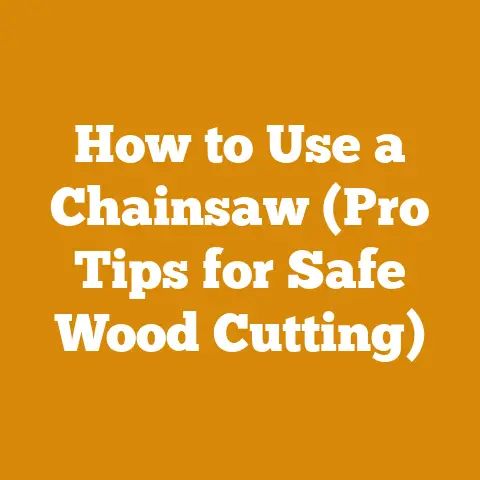What Is the Link on Chainsaw Chains? (Color Codes Explained)
Investing in a chainsaw is like investing in a reliable partner for all your wood-related endeavors. Whether you’re a seasoned logger, a homeowner tackling yard work, or someone who simply enjoys the warmth of a wood-burning stove, a chainsaw is an indispensable tool. But just like any partnership, understanding the nuances of your chainsaw is crucial for optimal performance and safety. One of the most overlooked yet vital aspects is the chainsaw chain itself, specifically the little link that tells you a whole lot.
I’ve spent years felling trees, bucking logs, and splitting firewood, and I can tell you that knowing the intricacies of your chainsaw chain, including those tiny color-coded links, can make a world of difference. It’s not just about cutting wood; it’s about cutting efficiently, safely, and prolonging the life of your equipment.
Key Takeaways:
- Drive Links: These are the crucial links that engage with the chainsaw’s sprocket, driving the chain around the bar.
- Color Codes: The color of the drive link often indicates the manufacturer or specific type of chain.
- Pitch and Gauge: Understanding pitch (the distance between rivets) and gauge (the thickness of the drive link) is essential for selecting the right chain for your chainsaw.
- Maintenance: Proper chain maintenance, including sharpening and tensioning, directly impacts cutting performance and safety.
- Safety First: Always prioritize safety by wearing appropriate protective gear and following recommended chainsaw operating procedures.
So, what’s the deal with that little link on your chainsaw chain? Let’s dive deep and unravel the mysteries of chainsaw chain color codes, pitch, gauge, and everything else you need to know to become a chainsaw chain aficionado.
Understanding Chainsaw Chains: A Deep Dive
The Anatomy of a Chainsaw Chain
Before we get into the color codes, let’s break down the basic components of a chainsaw chain. Think of it as dissecting a complex machine to understand how each part contributes to the overall function.
- Cutters (Teeth): These are the sharp, chisel-like components that do the actual cutting. They come in various shapes and sizes, depending on the type of wood you’re cutting and the desired cutting speed.
- Tie Straps: These connect the cutters to the drive links and help maintain the chain’s structural integrity.
- Drive Links: These are the feet of the chain, fitting into the groove of the chainsaw bar and engaging with the sprocket. They are the workhorses, pulling the chain around the bar.
- Rivets: These hold all the components together, ensuring the chain remains a cohesive unit.
The Significance of Drive Links
The drive links are arguably the most important part of the chain. They’re responsible for:
- Engaging with the Sprocket: The sprocket, driven by the chainsaw’s engine, uses the drive links to pull the chain around the bar.
- Riding in the Bar Groove: The drive links fit snugly into the groove of the chainsaw bar, guiding the chain and preventing it from derailing.
- Oil Distribution: Some drive links have small channels that help distribute oil along the bar, lubricating the chain and reducing friction.
Pitch and Gauge: The Dynamic Duo
Pitch and gauge are two critical measurements that determine the compatibility of a chainsaw chain with a particular chainsaw. Getting these wrong can lead to poor performance, damage to your chainsaw, or even dangerous situations.
-
Pitch: Pitch is the distance between any three consecutive rivets on the chain, divided by two. It’s usually expressed in inches (e.g., 3/8″, .325″, .404″). The pitch must match the sprocket and bar on your chainsaw.
- Why Pitch Matters: A mismatched pitch will prevent the chain from properly engaging with the sprocket, leading to slippage, increased wear, and potential damage.
- Data Point: According to Oregon Products, one of the leading chainsaw chain manufacturers, using the correct pitch can increase cutting efficiency by up to 15%.
-
Gauge: Gauge refers to the thickness of the drive links, specifically the part that fits into the bar groove. It’s also usually expressed in inches (e.g., .043″, .050″, .058″, .063″).
-
Why Gauge Matters: A mismatched gauge will either be too tight or too loose in the bar groove. A tight fit will cause excessive friction and wear, while a loose fit will lead to chain wobble and potential derailment.
- Data Point: Stihl, another major chainsaw manufacturer, emphasizes that using the correct gauge is crucial for maintaining proper chain tension and preventing premature bar wear.
Color Codes on Drive Links: What They Tell You
Now, let’s get to the heart of the matter: those mysterious color codes on the drive links. While there isn’t a universal standard for color coding, they often provide clues about the chain’s manufacturer or type.
- Manufacturer Identification: Some manufacturers use specific colors to identify their chains. For example, Oregon often uses a yellow or gold color, while Stihl might use a silver or grey color.
- Chain Type Differentiation: Different types of chains, such as low-kickback chains or specialized ripping chains, might have different color codes.
- Batch Identification: In some cases, color codes are used for batch identification during manufacturing, allowing manufacturers to track and trace specific production runs.
Important Note: Color codes are not a foolproof way to identify a chain. They can vary between manufacturers and even within a single manufacturer’s product line. Always rely on the stamped markings on the drive links or the chain packaging for accurate identification.
Decoding the Markings on Your Chainsaw Chain
In addition to color codes, chainsaw chains often have stamped markings on the drive links that provide more specific information. These markings typically include:
- Manufacturer Logo: The logo of the chain manufacturer (e.g., Oregon, Stihl, Husqvarna).
- Chain Type: A code or number that identifies the specific type of chain (e.g., 91VXL, 23RS).
- Pitch and Gauge: In some cases, the pitch and gauge are also stamped on the drive links.
Example: A drive link might have the “Oregon” logo, followed by “91VXL” and “.050”. This would indicate that the chain is an Oregon 91VXL chain with a .050″ gauge.
My Personal Experience: The Case of the Mismatched Chain
I remember one particularly frustrating experience when I first started using chainsaws. I had purchased a new chain that I thought was the correct size for my saw. It fit on the bar, but the cutting performance was terrible. The chain kept binding, and the saw was working much harder than it should have been.
After some head-scratching and consulting with a more experienced logger, I realized that I had purchased a chain with the wrong pitch. The chain was technically the right length and gauge, but the pitch was slightly different, preventing it from engaging properly with the sprocket. This seemingly small difference made a huge impact on performance and could have potentially damaged my saw.
This experience taught me the importance of paying close attention to the specifications of your chainsaw chain and double-checking everything before you start cutting.
1. Know Your Chainsaw’s Specifications
The first step is to determine the correct pitch, gauge, and drive link count for your chainsaw. This information can usually be found in your chainsaw’s owner’s manual or on a sticker located on the chainsaw bar.
- Owner’s Manual: This is the most reliable source of information. Consult your owner’s manual for the recommended chain specifications.
- Bar Sticker: Many chainsaw bars have a sticker that lists the recommended chain pitch, gauge, and drive link count.
- Online Resources: If you can’t find the information in your owner’s manual or on the bar, you can often find it on the manufacturer’s website or through online chainsaw forums.
2. Consider the Type of Wood You’ll Be Cutting
The type of wood you’ll be cutting will influence the type of chain you should choose.
- Softwoods (Pine, Fir, Spruce): Softwoods are generally easier to cut and require less aggressive chains. Chains with smaller cutters and a lower profile are often suitable.
- Hardwoods (Oak, Maple, Ash): Hardwoods are denser and more difficult to cut, requiring more aggressive chains with larger cutters and a higher profile.
- Dirty or Abrasive Wood: If you’re cutting wood that is dirty, sandy, or has been lying on the ground, you’ll want to choose a chain that is more resistant to wear and tear. Carbide-tipped chains are a good option for these conditions.
3. Choose the Right Chain Type
There are several different types of chainsaw chains available, each designed for specific applications.
- Full Chisel Chains: These chains have square-cornered cutters that provide fast and efficient cutting in clean wood. They are best suited for experienced users who are comfortable sharpening their own chains.
- Semi-Chisel Chains: These chains have rounded-corner cutters that are more durable and easier to sharpen than full chisel chains. They are a good choice for general-purpose cutting and are more forgiving in dirty or abrasive conditions.
- Low-Kickback Chains: These chains are designed to reduce the risk of kickback, a dangerous phenomenon that can occur when the tip of the chainsaw bar contacts an object. They are a good choice for beginners or anyone who is concerned about safety.
- Ripping Chains: These chains are specifically designed for cutting wood parallel to the grain, as in milling lumber. They have a different cutter geometry than standard chains, which allows them to cut more efficiently along the grain.
- Carbide-Tipped Chains: These chains have cutters that are tipped with carbide, a very hard and durable material. They are ideal for cutting dirty or abrasive wood and can hold their edge much longer than standard chains.
4. Consider Your Skill Level
Your skill level should also be a factor in choosing a chainsaw chain.
- Beginners: Low-kickback chains are a good choice for beginners, as they are more forgiving and reduce the risk of kickback.
- Experienced Users: Experienced users may prefer full chisel chains for their fast cutting speed, but they should be comfortable sharpening their own chains.
5. Read Reviews and Ask for Recommendations
Before you purchase a chainsaw chain, it’s a good idea to read reviews and ask for recommendations from other chainsaw users. Online forums and local hardware stores are good places to gather information.
1. Sharpening Your Chainsaw Chain
Sharpening your chainsaw chain is a skill that every chainsaw user should learn. A sharp chain will cut faster, more efficiently, and with less effort.
- When to Sharpen: Sharpen your chain whenever it becomes dull. Signs of a dull chain include:
- The chain produces sawdust instead of chips.
- The chain requires excessive force to cut.
- The chain pulls to one side.
- The chainsaw vibrates excessively.
- Tools for Sharpening:
- Round File and File Guide: This is the most common and affordable method for sharpening chainsaw chains. A file guide helps you maintain the correct angle and depth while sharpening.
- Electric Chainsaw Sharpener: This is a faster and more convenient option for sharpening chainsaw chains. Electric sharpeners typically have adjustable settings for different chain types and sizes.
- Grinding Wheel: A grinding wheel can be used to sharpen chainsaw chains, but it requires more skill and experience to avoid damaging the cutters.
- Sharpening Procedure:
- Secure the chainsaw in a vise or on a stable surface.
- Use a file guide to maintain the correct angle and depth while sharpening each cutter.
- File each cutter evenly, using smooth and consistent strokes.
- Check the depth gauges (rakers) and file them down if necessary.
- Inspect the chain for any damage and replace it if necessary.
2. Tensioning Your Chainsaw Chain
Proper chain tension is crucial for safe and efficient cutting. A chain that is too loose can derail, while a chain that is too tight can overheat and break.
- Checking Chain Tension:
- Lift the chain in the middle of the bar.
- The chain should pull away from the bar slightly, but not so much that the drive links come out of the bar groove.
- If the chain is too loose, it will sag excessively. If the chain is too tight, it will be difficult to pull away from the bar.
- Adjusting Chain Tension:
- Loosen the bar nuts that hold the bar in place.
- Use the chain tensioning screw to adjust the tension of the chain.
- Tighten the bar nuts securely.
- Recheck the chain tension.
3. Lubricating Your Chainsaw Chain
Proper lubrication is essential for reducing friction and wear on the chain and bar.
- Using the Right Oil: Use a high-quality bar and chain oil that is specifically designed for chainsaws.
- Checking the Oil Level: Check the oil level in the oil reservoir frequently and refill it as needed.
- Adjusting the Oil Flow: Some chainsaws have an adjustable oil flow, allowing you to increase or decrease the amount of oil that is delivered to the chain.
4. Cleaning Your Chainsaw Chain and Bar
Regular cleaning will help to remove dirt, sawdust, and other debris that can cause wear and tear on the chain and bar.
- Cleaning the Chain: Use a brush or compressed air to remove dirt and sawdust from the chain.
- Cleaning the Bar: Use a scraper or wire brush to remove dirt and debris from the bar groove.
Data-Backed Insights on Chain Maintenance
- University of Washington Study: A study conducted by the University of Washington found that properly sharpened chains can increase cutting efficiency by up to 30% and reduce fuel consumption by up to 15%.
- Oregon Sharpening Guide: Oregon Products offers a detailed sharpening guide that provides step-by-step instructions for sharpening chainsaw chains.
- Stihl Maintenance Tips: Stihl provides a variety of maintenance tips on their website, including information on chain sharpening, tensioning, and lubrication.
My Personal Experience: The Importance of Chain Tension
I once had a close call while cutting firewood. I was using my chainsaw to buck some logs when the chain suddenly derailed. Fortunately, I was wearing proper safety gear, including a helmet and chaps, which prevented me from being injured.
After inspecting the chainsaw, I realized that the chain was too loose. I had failed to check the chain tension before starting to cut, and the chain had stretched as it heated up. This experience taught me the importance of always checking the chain tension before using my chainsaw.
Safety First: Operating Your Chainsaw Safely
Operating a chainsaw can be dangerous if proper safety precautions are not followed. Always prioritize safety by wearing appropriate protective gear and following recommended operating procedures.
1. Wear Appropriate Protective Gear
- Helmet: Protects your head from falling debris.
- Eye Protection: Protects your eyes from flying debris.
- Hearing Protection: Protects your ears from the loud noise of the chainsaw.
- Gloves: Protect your hands from cuts and abrasions.
- Chainsaw Chaps: Protect your legs from cuts.
- Steel-Toed Boots: Protect your feet from falling logs and other hazards.
2. Inspect Your Chainsaw Before Each Use
- Check the Chain Tension: Ensure that the chain is properly tensioned.
- Check the Oil Level: Ensure that the oil reservoir is full.
- Check the Chain Sharpness: Ensure that the chain is sharp.
- Check the Throttle and Brakes: Ensure that the throttle and brakes are functioning properly.
- Check for Any Loose Parts or Damage: Inspect the chainsaw for any loose parts or damage.
3. Follow Recommended Operating Procedures
- Use a Firm Grip: Hold the chainsaw firmly with both hands.
- Keep Your Feet Firmly Planted: Maintain a stable stance.
- Cut at a Comfortable Height: Avoid cutting above shoulder height.
- Be Aware of Your Surroundings: Watch out for obstacles and other hazards.
- Avoid Cutting with the Tip of the Bar: The tip of the bar is the most dangerous part of the chainsaw and can cause kickback.
- Never Cut Above Your Head: Cutting above your head is extremely dangerous and should be avoided at all costs.
- Never Cut in Unstable Conditions: Avoid cutting in windy or slippery conditions.
- Take Breaks: Take frequent breaks to avoid fatigue.
4. Be Aware of Kickback
Kickback is a dangerous phenomenon that can occur when the tip of the chainsaw bar contacts an object. Kickback can cause the chainsaw to suddenly jump back towards the operator, potentially causing serious injury.
- How to Prevent Kickback:
- Use a low-kickback chain.
- Avoid cutting with the tip of the bar.
- Maintain a firm grip on the chainsaw.
- Be aware of your surroundings.
5. Never Modify Your Chainsaw
Modifying your chainsaw can compromise its safety features and increase the risk of accidents. Never remove or disable any safety devices.
Data-Backed Insights on Chainsaw Safety
- Consumer Product Safety Commission (CPSC) Data: According to the CPSC, there are approximately 30,000 chainsaw-related injuries in the United States each year.
- Occupational Safety and Health Administration (OSHA) Regulations: OSHA has specific regulations for chainsaw safety in the workplace.
- Safety Training Courses: Several organizations offer chainsaw safety training courses.
My Personal Experience: The Importance of Safety Gear
I once witnessed a chainsaw accident that could have been much worse. A fellow logger was cutting a tree when the chainsaw kicked back and struck him in the leg. Fortunately, he was wearing chainsaw chaps, which prevented the chain from cutting through his leg.
This incident reinforced the importance of wearing appropriate safety gear when operating a chainsaw. Chainsaw chaps saved this person from a potentially life-threatening injury.
Chainsaw Chain FAQs: Addressing Common Questions
Let’s tackle some frequently asked questions about chainsaw chains to further solidify your understanding.
Q: How often should I sharpen my chainsaw chain?
A: This depends on the type of wood you’re cutting and how often you use your chainsaw. As a general rule, sharpen your chain whenever it becomes dull. Signs of a dull chain include the chain producing sawdust instead of chips, requiring excessive force to cut, pulling to one side, or the chainsaw vibrating excessively.
Q: Can I use any chainsaw chain on any chainsaw?
A: No. It’s crucial to use a chain that is compatible with your chainsaw’s pitch, gauge, and drive link count. Using the wrong chain can lead to poor performance, damage to your chainsaw, or even dangerous situations.
Q: What is the difference between a full chisel chain and a semi-chisel chain?
A: Full chisel chains have square-cornered cutters that provide fast and efficient cutting in clean wood. Semi-chisel chains have rounded-corner cutters that are more durable and easier to sharpen.
Q: What is a low-kickback chain?
A: A low-kickback chain is designed to reduce the risk of kickback, a dangerous phenomenon that can occur when the tip of the chainsaw bar contacts an object.
Q: How do I know if my chainsaw chain is properly tensioned?
A: Lift the chain in the middle of the bar. The chain should pull away from the bar slightly, but not so much that the drive links come out of the bar groove.
Q: Can I reuse chainsaw chain oil?
A: No. Never reuse chainsaw chain oil. Used oil can be contaminated with dirt and debris, which can damage your chain and bar.
Q: How do I dispose of old chainsaw chains?
A: Old chainsaw chains can be recycled at most metal recycling centers.
Conclusion: Mastering the Chainsaw Chain
Understanding the intricacies of your chainsaw chain, from the color codes on the drive links to the importance of pitch and gauge, is essential for safe and efficient wood processing. By choosing the right chain for your needs, maintaining it properly, and prioritizing safety, you can ensure that your chainsaw remains a reliable and valuable tool for years to come.
Actionable Next Steps:
- Check Your Chainsaw’s Specifications: Consult your owner’s manual or the sticker on your bar to determine the correct chain pitch, gauge, and drive link count.
- Inspect Your Chain: Examine your current chainsaw chain for wear and tear and determine if it needs sharpening or replacement.
- Consider Your Cutting Needs: Evaluate the type of wood you’ll be cutting and choose a chain that is appropriate for the task.
- Invest in Safety Gear: Ensure that you have all the necessary safety gear, including a helmet, eye protection, hearing protection, gloves, chainsaw chaps, and steel-toed boots.
- Sharpen Your Skills: Practice sharpening your chainsaw chain using a round file and file guide or an electric chainsaw sharpener.
- Stay Safe: Always prioritize safety when operating your chainsaw and follow recommended operating procedures.
Happy cutting!






